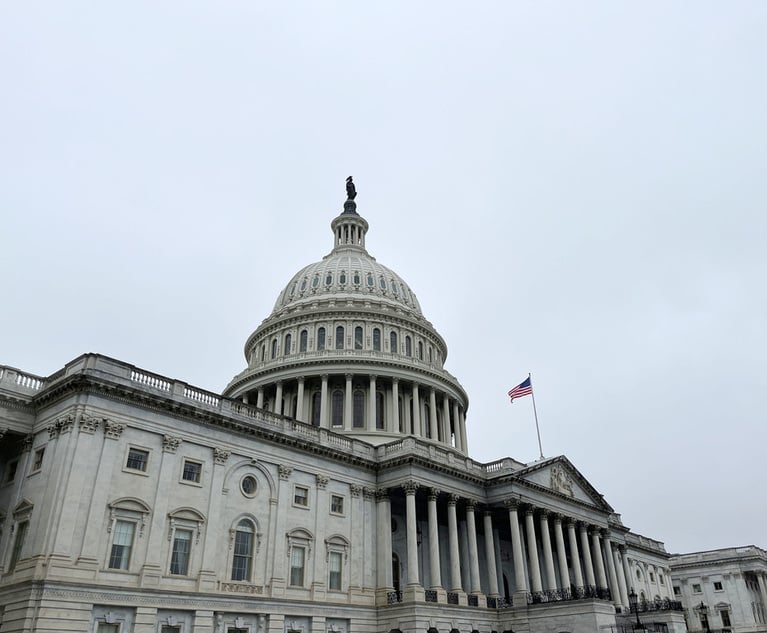Here's What Health Care Lawyers Are Saying About Trump's Latest ACA Moves
Health care lawyers weigh in on two actions taken late last week by the Trump administration to start dismantling the Affordable Care Act.
October 17, 2017 at 12:53 PM
5 minute read
 Affordable Care Act application on Healthcare.gov site.
Affordable Care Act application on Healthcare.gov site.
By Kristen Rasmussen
President Donald Trump late last week made good on a threat to simply stop making insurer subsidies under the Affordable Care Act. He also directed the Labor, Treasury, and Health and Human Services Departments to allow small businesses and individuals to obtain non-ACA-compliant health care plans.
An executive order, signed by Trump on Thursday, seeks to expand small businesses' and even individuals' ability to buy health insurance through nationwide association health plans. Health insurance is regulated by the states. Those changes to the law will require notice and comments and could take effect by the 2019 benefit year.
Later Thursday, the Trump administration announced that it would immediately stop making cost-sharing reduction payments (CSRs), which were designed to offset the cost of discounts that insurers were required to give eligible lower-income Americans under the ACA, also known as Obamacare.
Then, on Friday, New York Attorney General Eric Schneiderman announced a lawsuit filed by 19 attorneys general, including California AG Xavier Becerra, to defend those health care subsidies. The group of AGs in August won a motion to intervene in a 2014 lawsuit filed by House Republicans challenging the legality of insurer subsidies.
According to the New York Times, two top U.S. senators reached a bipartisan deal Tuesday to fund the subsidies to health insurers that Trump said he would cut last week.![]()
While the changes begin to make their way through the federal courts and regulatory agencies, American Lawyer Media reached out to health care lawyers nationally for their observations about the Trump administration's latest attempt at health care reform. Here's a snapshot of what some of them had to say.
Carrie Byrnes of Michael Best & Friedrich: How impactful the order will be will depend largely on how the secretaries take action in response to it. All that is called for under the order is “consideration” of changes by the impacted secretaries. Whether and how they determine that they can effectuate changes under the current law (without any legislative action) remains to be seen. Any responsive rule-making we receive in the wake of this order will take many months to work through the notice and comment period. The scope of any rule-making issued (even in proposed form) will likely also impact when Congress revives its repeal-and-replace efforts. The enhanced focus on federal tax reform may continue if the rule-making is impactful from a Republican perspective. It seems unlikely that the order will be sufficient in and of itself to avoid further efforts by the Republicans in Congress to restrict spending and repeal the individual and employer mandates, but the order may facilitate a delay in that regard.
Claire Cowart Haltom of Baker, Donelson, Bearman, Caldwell & Berkowitz: The Trump administration's decision to end Obamacare cost-sharing subsidies is viewed by many as a political move to force congressional Democrats to engage in the repeal-and-replace conversation. With premiums for 2018 spiking 20 percent, and more than $7 billion in subsidies abruptly withdrawn, it is individual purchasers and insurers outside of Washington who will suffer the most from this abrupt political maneuver. If last week's political move doesn't advance the conversation in Congress, we should expect additional executive orders to further dismantle Obamacare. President Trump has found the Obamacare destabilization levers and he's showing us he's not afraid to pull them.
D. Brian Hufford of Zuckerman Spaeder: After failing to “repeal and replace” Obamacare, President Trump elected to sabotage the Affordable Care Act so he could blame Democrats if it collapsed. In doing so, he ignored the adverse impact on millions of Americans. His first executive order allowing the formation of health care plans which will not have to comply with the ACA's “essential benefits” requirement means that many young and healthy people will be self-directed to limited, low-cost plans that leave them dramatically underinsured, while older and sicker people (with pre-existing conditions) will be forced into high-cost policies that could price them out of the market. His second executive order withholding promised payments to insurance companies to give them incentives to reduce out-of-pocket costs for low-income insureds will lead to skyrocketing premiums, while many insurers may elect to leave the market entirely. It is time for elected officials to make decisions based on policy, not politics.
Mark Rust of Barnes & Thornburg: The permission to market less-expensive, ACA non-compliant health plans will be very effective in reducing insurance policy prices for healthy people looking for alternatives to expensive public-market plans. Those who object to what the policies do and do not cover proceed from the belief that only ACA-defined benefits—not free-market preferences—can define what a “good” policy is. Time will tell which proves to be true in the public mind. In the short term, however, it will have the effect in 2019 (too late for 2018) of driving exchange prices up, as sick people stay and healthier people have the opportunity to leave. The only solution to this chaos will require a congressional rethinking of how to create a proper insurance pool that includes people with pre-existing conditions.
Contact reporter Kristen Rasmussen at [email protected].
This content has been archived. It is available through our partners, LexisNexis® and Bloomberg Law.
To view this content, please continue to their sites.
Not a Lexis Subscriber?
Subscribe Now
Not a Bloomberg Law Subscriber?
Subscribe Now
NOT FOR REPRINT
© 2025 ALM Global, LLC, All Rights Reserved. Request academic re-use from www.copyright.com. All other uses, submit a request to [email protected]. For more information visit Asset & Logo Licensing.
You Might Like
View All
Government Attorneys Face Reassignment, Rescinded Job Offers in First Days of Trump Administration
4 minute read
RFK Jr. Will Keep Affiliations With Morgan & Morgan, Other Law Firms If Confirmed to DHHS
3 minute read
Am Law 200 Firms Announce Wave of D.C. Hires in White-Collar, Antitrust, Litigation Practices
3 minute readTrending Stories
- 1In Novel Oil and Gas Feud, 5th Circuit Gives Choice of Arbitration Venue
- 2Jury Seated in Glynn County Trial of Ex-Prosecutor Accused of Shielding Ahmaud Arbery's Killers
- 3Ex-Archegos CFO Gets 8-Year Prison Sentence for Fraud Scheme
- 4Judges Split Over Whether Indigent Prisoners Bringing Suit Must Each Pay Filing Fee
- 5Law Firms Report Wide Growth, Successful Billing Rate Increases and Less Merger Interest
Who Got The Work
J. Brugh Lower of Gibbons has entered an appearance for industrial equipment supplier Devco Corporation in a pending trademark infringement lawsuit. The suit, accusing the defendant of selling knock-off Graco products, was filed Dec. 18 in New Jersey District Court by Rivkin Radler on behalf of Graco Inc. and Graco Minnesota. The case, assigned to U.S. District Judge Zahid N. Quraishi, is 3:24-cv-11294, Graco Inc. et al v. Devco Corporation.
Who Got The Work
Rebecca Maller-Stein and Kent A. Yalowitz of Arnold & Porter Kaye Scholer have entered their appearances for Hanaco Venture Capital and its executives, Lior Prosor and David Frankel, in a pending securities lawsuit. The action, filed on Dec. 24 in New York Southern District Court by Zell, Aron & Co. on behalf of Goldeneye Advisors, accuses the defendants of negligently and fraudulently managing the plaintiff's $1 million investment. The case, assigned to U.S. District Judge Vernon S. Broderick, is 1:24-cv-09918, Goldeneye Advisors, LLC v. Hanaco Venture Capital, Ltd. et al.
Who Got The Work
Attorneys from A&O Shearman has stepped in as defense counsel for Toronto-Dominion Bank and other defendants in a pending securities class action. The suit, filed Dec. 11 in New York Southern District Court by Bleichmar Fonti & Auld, accuses the defendants of concealing the bank's 'pervasive' deficiencies in regards to its compliance with the Bank Secrecy Act and the quality of its anti-money laundering controls. The case, assigned to U.S. District Judge Arun Subramanian, is 1:24-cv-09445, Gonzalez v. The Toronto-Dominion Bank et al.
Who Got The Work
Crown Castle International, a Pennsylvania company providing shared communications infrastructure, has turned to Luke D. Wolf of Gordon Rees Scully Mansukhani to fend off a pending breach-of-contract lawsuit. The court action, filed Nov. 25 in Michigan Eastern District Court by Hooper Hathaway PC on behalf of The Town Residences LLC, accuses Crown Castle of failing to transfer approximately $30,000 in utility payments from T-Mobile in breach of a roof-top lease and assignment agreement. The case, assigned to U.S. District Judge Susan K. Declercq, is 2:24-cv-13131, The Town Residences LLC v. T-Mobile US, Inc. et al.
Who Got The Work
Wilfred P. Coronato and Daniel M. Schwartz of McCarter & English have stepped in as defense counsel to Electrolux Home Products Inc. in a pending product liability lawsuit. The court action, filed Nov. 26 in New York Eastern District Court by Poulos Lopiccolo PC and Nagel Rice LLP on behalf of David Stern, alleges that the defendant's refrigerators’ drawers and shelving repeatedly break and fall apart within months after purchase. The case, assigned to U.S. District Judge Joan M. Azrack, is 2:24-cv-08204, Stern v. Electrolux Home Products, Inc.
Featured Firms
Law Offices of Gary Martin Hays & Associates, P.C.
(470) 294-1674
Law Offices of Mark E. Salomone
(857) 444-6468
Smith & Hassler
(713) 739-1250









